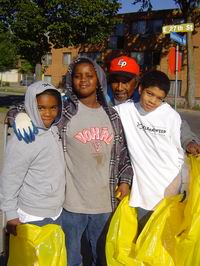I-35W Access Concept Layouts Approved
City and County Also Adopt Transit Lane Policy
Timed to send a positive signal to Allina Hospitals and Clinics as it considered the Midtown Exchange project at the former Sears site for a new corporate headquarters, the Hennepin County Board of Commissioners and Minneapolis City Council adopted resolutions (on January 27, 2004, and January 30, 2004) approving the Preferred Build Alternative concept plan for the I-35W Access Project. Both the County Board and the City Council also approved new policy to support freeway capacity improvements in the form of a fifth lane in each direction for Bus Rapid Transit.
As local government acted, South Minneapolis neighborhoods also stated their strong support for Access and Allina.
On February 10, the Phillips and Midtown Community Works Partnerships joined to present the grand opening ceremony for Carne Asada, a new Mexican restaurant at Chicago-Lake and the latest in a series of major improvements there.
The next week, Allina announced that it would indeed consolidate its corporate operations in the Midtown Exchange, bringing more than 1,000 mostly professional jobs to Phillips.
Peter McLaughlin, County Commissioner
“This resolution comes about after almost a decade of effort by both public and private sectors to help restore an economic base in the Phillips Neighborhood. That’s what this is about. There has been investment in fighting crime. There has been an investment in housing. There has been investment in job training, tied particularly to the hospital in the Phillips Neighborhood, but in other areas as well. And, there was an effort to try to invest in needed infrastructure.”
Mayor R.T. Rybak
“It’s time to call the question, and to move forward with this as part of a larger vision in which we provide access to more people to this area, in which we can integrate that with bus rapid transit on 35W and the transportation vision we have for the Midtown Greenway and the innovative way we’re beginning to look at restructuring Lake Street.”
“This is correcting something that is probably one of the most short sighted urban planning mistakes that I can think of in the Twin Cities. Access will be good, and all the small business owners on Lake Street know it. These are small, mom-and-pop operations that provide the majority of new job growth in the country today. And they know that this project is going to improve small businesses.”
Gail Dorfman, County Commissioner
“This has been an intense process, with over 250 community meetings, but truly unique partnerships were created. Together, we have figured out a new way to plan the future of this major highway. And the community participation has resulted in major design improvements. We have done a pretty good job balancing all of the different interests. This is not the end of the process, and so we will continue working with the neighborhoods and the businesses and MnDOT up until the day that construction begins on this project.”
Paul Ostrow, Council President
“We need to applaud the tremendous progress that’s been made.”
“The decisions that were made in the 1960’s with freeway construction certainly contributed to the economic decline of Lake Street and nearby businesses. Decisions that I think would not be made that way now if people had the foresight to see what would happen."
















